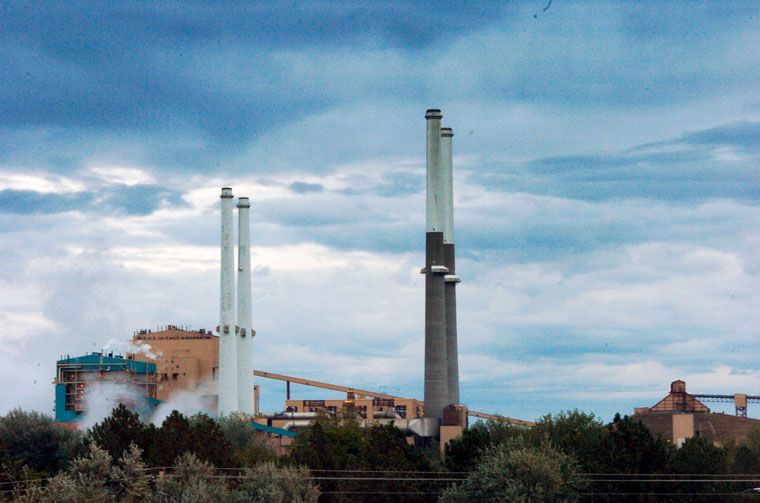
WASHINGTON (AP) — The Trump administration has granted nearly 70 coal-fired power plants a two-year exemption from federal requirements to reduce emissions of toxic chemicals such as mercury, arsenic, and benzene.
A list posted as of Tuesday on the Environmental Protection Agency’s website lists 47 power providers—which operate at least 66 coal-fired plants—that are receiving exemptions from the Biden-era rules under the Clean Air Act, including a regulation limiting air pollution from mercury and other toxins. The actions follow an executive order last week by President Donald Trump aimed at boosting the struggling coal industry, a reliable but polluting energy source that’s long been in decline.
Among plants receiving exemptions is the Colstrip Generating Station, a massive power plant in Colstrip, Montana, that emits more toxic air pollutants such as lead and arsenic than any other U.S. facility of its kind, according to the EPA. Other plants with exemptions include Coal Creek Station, a large power plant in North Dakota that is among the nation’s top producers of mercury emissions, and the Oak Grove plant in Texas, another large polluter.
The exempted plants are owned by some of the nation’s largest power companies, including Talen Energy, Dominion Energy, NRG Energy, and Southern Co.
The exemptions also apply to four plants operated by the Tennessee Valley Authority, the nation’s largest public utility.
The EPA said in a statement Tuesday that the presidential exemptions “will bolster coal-fired electricity generation, ensuring that our nation’s grid is reliable, that electricity is affordable for the American people, and that EPA is helping to promote our nation’s energy security.”
Michelle Bloodworth, president and CEO of industry group America’s Power, a lobbying group for coal-fired plants, said Trump recognizes that the nation’s coal fleet is “essential to maintaining a healthy and secure electricity supply – the backbone of our economy.”
Rules imposed under former President Joe Biden “were inconsistent with the Clean Air Act and based on an improper analysis of data,” she said. “We just feel like the last administration, all of these regulations were really designed to force the closure of coal plants.”
Now, as data centers and other needs cause electricity demand to soar, Bloodworth says coal power is increasingly essential.
The mercury rule, finalized last year, could have contributed to the premature retirement of dozens of coal units, Bloodworth said, adding that the plants are needed to support reliability of the electric grid.
Environmentalists called the exemptions—which require a presidential finding that technology required to meet the new rules is not widely available and that continued activity of the plants advances national security—a dereliction of duty by Trump and EPA Administrator Lee Zeldin.
“These passes to pollute carve a ragged hole through the heart of federal protections for the air we breathe,” said Maya Golden-Krasner, a senior attorney at the Center for Biological Diversity, an environmental group. “To suggest that it’s a matter of national security to force people from Montana to Alabama to inhale more neurotoxins is offensive. This is what it looks like to put polluter profits ahead of the wellbeing of Americans and the planet.”
Environmental groups and public health advocates have denounced the administration’s plan to grant exemptions, which they say could allow hundreds of companies to evade laws meant to protect the environment and public health.
They worry about coal ash and its heavy metals in part because there’s so much of it – more than 100 million tons is produced each year, much of which sits near lakes and rivers in sprawling disposal sites. Some is reused, but a lot is stored near coal plants in coal ash ponds that may not have a lining to keep it from leaching into groundwater.
It can be disastrous when companies fail to keep that waste in place. In 2008, a huge dike burst at a Tennessee coal plant. That released more than a billion gallons of coal ash, polluting rivers, toppling homes, and potentially shortening the lives of many cleanup workers who spent months exposed to its toxicity.
That disaster helped lead to the first federal standards for coal ash disposal in 2015. Those included requirements for companies to line new storage sites, conduct water monitoring, and ensure many leaky ponds closed safely, often requiring the material to be moved elsewhere.
“It contains a lot of important protections, but it didn’t apply to all the coal ash that utilities were managing,” said Nick Torrey, an attorney with the nonprofit Southern Environmental Law Center.
Old coal ash piles at dozens of shuttered plants weren’t included. They are even more likely to be unlined and unsafe, according to the EPA. A federal appeals court in 2018 said old disposal areas at inactive sites threatened to catastrophically fail and pollute groundwater. The Biden administration wrote new rules to ensure those close properly. The rule also targeted the disposal of waste outside designated disposal areas.
The Biden administration also turned a skeptical eye toward states that wanted to manage their own coal ash permitting programs, and rejected Alabama’s request to do so, saying the state allowed coal ash sites to close without sufficiently protecting groundwater.
Now, EPA Administrator Lee Zeldin says the agency will work closely with states to help them take over permitting. Environmental groups are worried.
“They are basically just going to rubber-stamp the applications,” said Gavin Kearney, an attorney with the nonprofit Earthjustice.
And the Trump administration will weaken enforcement of some current rules. The Biden administration made enforcing coal ash rules a priority, sending officials to examine more than 100 sites. But new enforcement instructions in March said that effort was “motivated largely by environmental justice considerations,” a priority of the last administration aimed at improving conditions in polluted areas that are often majority-Black or Hispanic.
The updated guidance says enforcement at active power plants must focus on “imminent threats to human health,” making no mention of shuttered sites.
“The memo leaves room for EPA to enforce against active or inactive sites, but … I will be surprised if they do,” Kearney said.
The EPA estimated Biden’s rules would cost the industry as much as $240 million annually. America’s Power says forcing some plants to remove coal ash that sits below the water table, which they don’t believe is a significant threat to the area’s groundwater and drinking water, is extremely costly and can force shutdowns.
Bloodworth praised the change in direction.
“If there are three legs of the stool — affordability, reliability and sustainability — the (Biden) administration went way too far” and failed to properly prioritize reliability, Bloodworth said.
Exemptions can be given for nine EPA rules, including limits on mercury, ethylene oxide, and other hazardous air pollutants. Mercury exposure can cause brain damage, especially in children, and birth defects can occur after exposure in a mother’s womb.
Last week, in a series of executive orders, Trump used his emergency authority to allow some older coal-fired power plants set for retirement to keep producing electricity to meet rising U.S. power demand amid growth in data centers, artificial intelligence, and electric cars. Trump also directed federal agencies to identify coal resources on federal lands, lift barriers to coal mining, and prioritize coal leasing on U.S. lands.
Trump has long promised to boost what he calls “beautiful” coal to fire power plants and for other uses.
___
Written in part by Matthew Daly and Michael Phillis, Associated Press
___
Copyright 2025 The Associated Press. All rights reserved.
Tagged with coal, EPA




